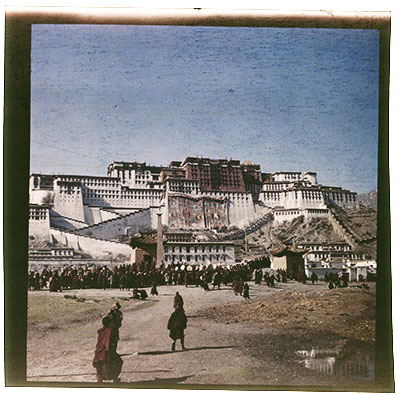
2001.59.8.94.1 (Transparency)


2001.59.8.94.1 (Transparency)

Hugh E. Richardson
Hugh Richardson
1949-50
Lhasa > Potala (from south)
2001.59.8.94.1
43 x 54 mm
Transparency Colour
Donated August 2001
The executors of the estate of Hugh E. Richardson
Hugh E. Richardson
This image has been flipped during scanning. You can compare the correct image above
Manual Catalogues - Notes on negative album '8' - 'Potala. Colour misc.' [on front cover] [KC 9/9/2006]
Manual Catalogues - Notes on negative index '8' - Folio 94 'Potala with Gosku banner' [KC 9/9/2006]
Research publication - Clare Harris and Tsering Shakya (eds.) 2003 'Seeing Lhasa: British Depictions of the Tibetan Capital 1936-1947' (Serindia Publications, Chicago). Page 130.
Other Information - The Potala Palace was named after Mount Potalaka, the abode of the bodhisattva of compassion (Chenrezi). Known locally as Tse Podrang (“Summit Palace”), its thirteen storeys rising up from the Marpori (Red Hill) dominate the Lhasa cityscape. Constructed at the order of the 5th Dalai Lama in the mid 17th century it was expanded during the 18th century to become one of the world’s tallest buildings. The building performed several functions as the winter home of the Dalai Lama and seat of the Tibetan government. It also contains the tombs of several previous Dalai Lamas. Richardson took this photograph during the “Golden Procession” when on the 30th day of the ceremonial year sacred objects were taken from the Potala and paraded around the pilgrimage routes of Lhasa. The great Regent Sangye Gyatso started this festival in commemoration of a vision seen by the 5th Dalai Lama. After the procession the great banner or Köku (“The Silk Image”) is hauled up, covering the lower face of the palace. It is approximately 75 by 40 feet in size and consists of two panels with a huge figure of the Buddha surrounded by deities and bodhisattvas in the centre of each.
Other Information - Setting: The Potala Palace is the winter Palace of the Dalai Lamas and the seat of traditional Tibetan government. The palace is know as several names by the Tibetan, Tse Podrang, ( rtse pho brang ) or more formally, Potala Podrang ( pho brang po ta la ) The first structure was established by the legendary Tibetan Emperor Song Gampo on Mt Marpori in 637. The original structure is said to have been 11 stories high and was destroyed by lightening during the reign of Emperor Trisong Detsen. The present structure was built by the 5th Dalai Lama on the foundation of the earliest ruins. The Potala is divided into two parts, the central upper part is known as the Red Palace ( pho brang mar p o) and the surrounding structure is know as the White Palace ( pho brang dkar po ). The Red Palace contains the main temple inside the palace and housed the reliquaries of the successive Dalai Lamas. The Red Palace also represents the original structure build in the 7th Century. Between 1645-1653 the 5th Dalai Lama added the White Palace and made it the seat of his government. Since the 17th Century, the White Palace has formed the main administrative offices of the Tibetan government and it became the seat of Tibetan government only in the 18th Century when the 5th Dalai Lama shifted his base from Gaden Palace in Drepung monastery to the Potala. There are said to be over 1000 rooms and over 200,000 images inside. The grounds of the Potala also housed a school known as Tse Lobdra ( rtse slob grwa ) 'The Peak School'. The students were mostly boys from aristocratic families and trained to become government officials. The palace was also the site of two printing presses the older one known as Ganden Phuntsog Parkhang ( dpa’i ldan phun phyogs par khang ) founded in the 17th Century and in 1920s the 13th Dalai Lama established the Shol Printing House ( zhol par khang ). [TS 27/6/2005]
For Citation use:
The Tibet Album.
"Potala displaying Koku banner during Sertreng "
05 Dec. 2006. The Pitt Rivers Museum.
<http://tibet.prm.ox.ac.uk/photo_2001.59.8.94.1.html>.
For more information about photographic usage or to order prints, please visit the The Pitt Rivers Museum.
© The Pitt Rivers Museum